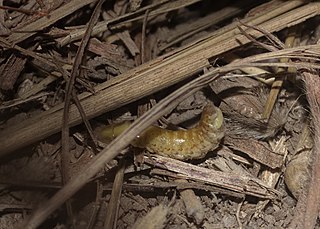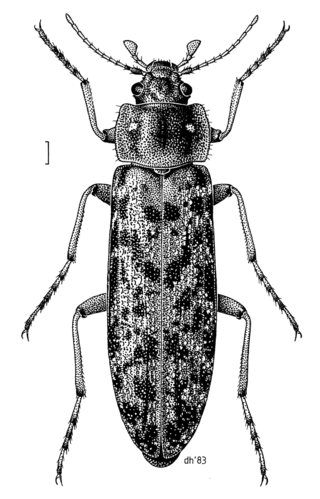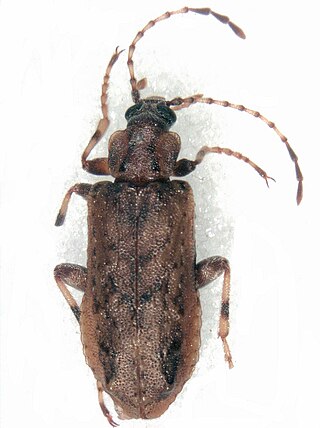
The family Scarabaeidae, as currently defined, consists of over 35,000 species of beetles worldwide; they are often called scarabs or scarab beetles. The classification of this family has undergone significant change in recent years. Several groups formerly treated as subfamilies have been elevated to family rank, and some reduced to lower ranks. The subfamilies listed in this article are in accordance with those in Catalog of Life (2023).

Hydrophilidae, also known colloquially as water scavenger beetles, is a family of beetles. Aquatic hydrophilids are notable for their long maxillary palps, which are longer than their antennae. Several of the former subfamilies of Hydrophilidae have recently been removed and elevated to family rank; Epimetopidae, Georissidae, Helophoridae, Hydrochidae, and Spercheidae. While the majority of hydrophilids are aquatic, around a third of described species are terrestrial, mostly belonging to the subfamily Sphaeridiinae.

Ochodaeidae, also known as the sand-loving scarab beetles, is a small family of scarabaeiform beetles occurring in many parts of the world.

Byrrhoidea is a superfamily of beetles belonging to Elateriformia that includes several families which are either aquatic or associated with a semi-aquatic habitat. Other than the superfamily Hydrophiloidea, most of the remaining Polyphagan beetles which are aquatic are in this superfamily.

The Rhagophthalmidae are a family of beetles within the superfamily Elateroidea. Members of this beetle family have bioluminescent organs on the larvae, and sometimes adults, and are closely related to the Phengodidae, though historically they have been often treated as a subfamily of Lampyridae, or as related to that family. Some recent evidence suggested that they were the sister group to the Phengodidae, and somewhat distantly related to Lampyridae, whose sister taxon was Cantharidae, but more reliable genome-based phylogenetics placed as the sister group to the Lampyridae.

The Chalcodryidae are a family of beetles in the superfamily Tenebrionoidea. It contains at least five species in two genera Chalcodrya and Philpottia, which are endemic to New Zealand. They are generally found associated with moss or lichen covered branches, with the larvae having been found to be associated with dead twigs. They are likely noctural, feeding on lichen and other plant material at night. The genera Sirrhas and Onysius, formerly placed in this family, have subsequently been transferred to Promecheilidae.
Agabetes is a genus of beetles in the family Dytiscidae, containing the following species:

Hoshihananomia is a genus of tumbling flower beetles in the family Mordellidae. There are at least 40 described species in Hoshihananomia.

Paramordellaria is a genus of tumbling flower beetles in the family Mordellidae. There are at least two described species in Paramordellaria.
Protognathinus is an extinct genus of stag beetle from the Eocene of Europe, known from the Messel Pit in Germany. This genus is known from the single species P. spielbergi.

Kenocoelus is a genus of rove beetles containing a number of species, all endemic to New Zealand. It is part of the Trichonychini tribe, in the Pselaphinae subfamily of Staphylinidae.

Pandeleteius is a genus of broad-nosed weevils in the family Curculionidae. There are over 150 described species in Pandeleteius, distributed across the Americas. Most species in the genus were described by Anne Howden.

Cybocephalidae is a family of sap, bark and fungus beetles in the order Coleoptera with a wide global distribution. The type genus Cybocephalus has more than 200 species in it and the entire family has about 220 species in all. Many species are predators of armoured scale insects (Diaspididae). There are four tarsal segments on all the legs. The body is only slightly longer than wide and very convex and shiny. They are small and about 1 to 3 mm long. The insect can roll into a ball like position with its downward facing head. The tarsomeres are lobed underneath. The family is sometimes treated as a subfamily within the Nitidulidae.

Bolboceratinae is a subfamily of earth-boring scarab beetles in the family Geotrupidae. There are about 8 genera and at least 40 described species in Bolboceratinae.

Trochoideus is a genus of handsome fungus beetles in the family Endomychidae. There are about 10 described species in Trochoideus.
Aulacothorax is a genus of flea beetles in the family Chrysomelidae. There are currently 51 described species in Aulacothorax found worldwide, 40 of which are found in the Indomalayan realm.
Hadromychus is a genus of handsome fungus beetles in the family Endomychidae. There is one described species in Hadromychus, H. chandleri.

Promecheilidae is a family of beetles in the superfamily Tenebrionoidea. Perimylopidae is considered a synonym. They are found in southern South America and associated archipelagos like South Georgia and the Falklands, New Zealand and Tasmania. Some species are associated tree ferns and moss-covered dead wood, and other forested habitats, while others are associated with peat bogs, grasslands and coastal habitats. They are probably phytophagus, feeding on lichen, moss, and other plant material.

Caccobius unicornis, is a species of dung beetle found in many Asian and South East Asian countries such as: India, Sri Lanka, China, Java, Borneo, Taiwan, Korea, Japan, Myanmar, North Vietnam, Philippines, Sumatra, Java, Borneo, Malaysia, Thailand, and Indochina.

Telegeusinae is a small subfamily of beetles in the family Omethidae recognizable by enlarged palpi found in males. Though relatively rare, males are sometimes found in large numbers in black light traps. Females are not known in this group, but it is theorized that females are larviform as found in many closely related taxa.
















